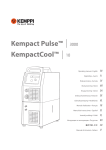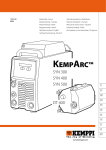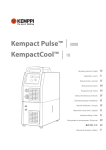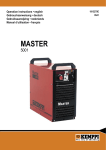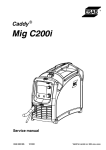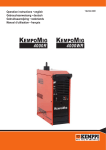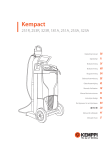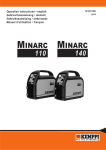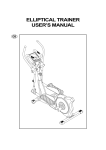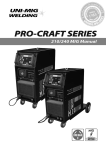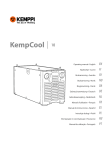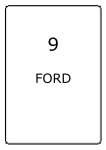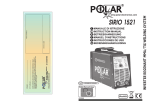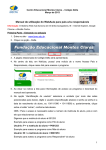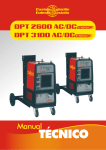Download KEMPARC™
Transcript
1920130 0808 Käyttöohje • Suomi Gebruiksaanwijzing • Nederlands Bruksanvisning • Svenska Manuel d’utilisation • Français Bruksanvisning • Norsk Manual de instrucciones • Español Brugsanvisning • Dansk Instrukcja obsługi • Polski Operating manual • English Инструкции по эксплуатации • По-русски Gebrauchsanweisung • Deutsch KEMPARC™ SYN 300 SYN 400 SYN 500 FI SV NO DT 400 DA EN DE NL FR ES PL RU Operating manual FI English SV NO DA EN DE NL FR ES PL RU KempArc SYN 300, 400, 500 / © Kemppi Oy / 0808 KempArc SYN 300, 400, 500 / © Kemppi Oy / 0808 Contents 1.PREFACE....................................................................................... 3 1.1 General. ................................................................................................................................................................ 3 1.2 Safety Instructions. ...................................................................................................................................... 3 1.3 Introduction...................................................................................................................................................... 5 2.USE................................................................................................ 6 2.1 Power source.................................................................................................................................................... 6 2.1.1 Power source components................................................................................................................ 6 2.1.2 Locating the power source................................................................................................................ 6 2.1.3 Connecting the power source to the electric network............................................................ 7 2.1.4 Connecting the cables......................................................................................................................... 8 2.1.5 Installing the field bus card............................................................................................................... 9 2.1.6 Starting the power source.............................................................................................................. 10 2.1.7 Power source indicators................................................................................................................... 10 2.2 Control panel. ............................................................................................................................................... 10 2.2.1 Control panel parts............................................................................................................................ 10 2.2.2 Adjusting MIG dynamics (Arc Force)........................................................................................... 11 2.2.3 Gas test................................................................................................................................................... 11 2.2.4 Wire feed test....................................................................................................................................... 11 2.2.5 Selection of liquid- or gas-cooled MIG gun.............................................................................. 12 2.2.6 Retrieving weld data......................................................................................................................... 12 2.2.7 Selecting the welding process...................................................................................................... 12 2.2.8 Additional MIG features included in the standard delivery................................................ 12 2.2.9 Optional additional MIG features................................................................................................. 14 2.2.10 Memory features (MEMORY button)........................................................................................... 14 2.2.11 Synergetic 1-MIG welding and AAA-MIG welding................................................................. 15 2.2.12 SETUP features of the control panel............................................................................................ 17 2.3 Wire feeder. .................................................................................................................................................... 18 FI 3.MAINTENANCE.......................................................................... 19 SV DA 3.1 Cables................................................................................................................................................................. 19 3.2 Power source................................................................................................................................................. 20 3.2.1. DuraTorque™ 400, 4-wheel wire feeder mechanism............................................................. 20 3.3 Regular maintenance.............................................................................................................................. 21 3.4 Disposal of the machine....................................................................................................................... 21 EN 4.TROUBLESHOOTING................................................................. 21 NO 4.1 4.2 4.3 4.4 4.5 DE NL FR Overload (yellow indicator lit).......................................................................................................... 21 Control cable connector fuse............................................................................................................ 21 Electric network overvoltage or undervoltage.................................................................... 21 Missing phase in the electric network........................................................................................ 22 Error codes...................................................................................................................................................... 22 5. ORDERING NUMBERS............................................................... 23 6.TECHNICAL DATA...................................................................... 23 7. WARRANTY POLICY................................................................... 25 ES PL RU 1.1General Congratulations on your choice of the Kemparc™ SYN-series welding system. Reliable and durable, Kemppi products are affordable to maintain, and they increase your work productivity. This user manual contains important information on the use, maintenance and safety of your Kemppi product. The technical specifications of the device can be found at the end of the manual. Please read the manual carefully before using the equipment for the first time. For your safety and that of your working environment, pay particular attention to the safety instructions in the manual. For more information on Kemppi products, contact Kemppi Oy, consult an authorised Kemppi dealer, or visit the Kemppi Web site at www.kemppi.com. The specifications presented in this manual are subject to change without prior notice. NOTE! Items in the manual that require particular attention in order to minimise damage and personal harm are indicated with this symbol. Read these sections carefully and follow their instructions. 1.2Safety Instructions KempArc SYN 300, 400, 500 / © Kemppi Oy / 0808 1.PREFACE Kemppi welding devices conform to international safety standards. Safety is an important issue in equipment design and manufacturing. Therefore, Kemppi welding solutions are unparalleled in safety. There are, however, always certain hazards involved in using welding equipment. Therefore, to ensure your personal safety and the safety of your working environment, carefully read the safety instructions below and respect them. Use of personal protective equipment • The arc and its reflecting radiation damage unprotected eyes. Shield your eyes and face appropriately before you start welding or observe welding. Also note the different requirements for the darkness of the screen in the mask as the welding current changes. • The arc radiation and spatters burn unprotected skin. Always wear protective gloves, clothing and footwear when welding. • Always wear hearing protection if the ambient noise level exceeds the allowable limit (e.g., 85 dB). FI General operating safety • Exercise caution when handling parts heated in welding. For example, the tip of the welding torch, the end of the welding rod and the work piece will heat during gouging to a burning temperature. • Never wear the device on the shoulder during welding and never suspend it by the carrying strap during welding. • Do not expose the machine to high temperatures, as this may cause damage to the machine. • Keep the torch cable and earthing cable as close to each other as possible throughout their length. Straighten any loops in the cables. This minimises your exposure to harmful magnetic fields, which may interfere with a pacemaker, for example. • Do not wrap the cables around the body. • In environments classified as dangerous, only use S-marked welding devices with a safe idle voltage level. These work environments include, for example, humid, hot or small spaces where the user may be directly exposed to the surrounding conductive pieces. Spatter and fire safety SV NO DA EN DE NL FR ES • Welding is always classified as hot work, so pay attention to fire safety regulations during welding and after it. • Remember that fire can break out from sparks even several hours after the welding work is completed. PL RU KempArc SYN 300, 400, 500 / © Kemppi Oy / 0808 • Protect the environment from welding spatter. Remove flammable materials, such as flammable fluids, from the welding vicinity and supply the welding site with adequate fire fighting equipment. • In special welding jobs, be prepared for hazards such as fire or explosion when welding container-type work pieces. • Never direct the spark spray or cutting spray of a grinder toward the welding machine or flammable materials. • Beware of hot objects or spatter falling on the machine when working above the machine. • Welding in flammable or explosive sites is absolutely forbidden. General electric safety • • • • • • Only connect the welding machine to an earthed electric network. Note the recommended mains fuse size. Do not take the welding machine inside a container, vehicle or similar work piece. Do not place the welding machine on a wet surface and do not work on a wet surface. Do not allow the mains cable to be directly exposed to water. Ensure cables or welding torches are not squashed by heavy objects and that they are not exposed to sharp edges or a hot work piece. • Make sure that faulty and damaged welding torches are changed immediately as they can be lethal and may cause electrocution or fire. • Remember that the cable, plugs and other electric devices may be installed or replaced only by an electrical contractor or engineer authorised to perform such operations. • Turn off the welding machine when it is not in use. Welding power circuit • Insulate yourself from the welding circuit by using dry and undamaged protective clothing. • Never touch the work piece and welding rod, welding wire, welding electrode or contact tip at the same time. • Do not put the welding torch or ground cable on the welding machine or other electric equipment. Welding fumes • Ensure proper ventilation and avoid inhaling the fumes. • Ensure sufficient supply of fresh air, particularly in closed spaces. You can also ensure the supply of clean and sufficient breathing air by using a fresh-air mask. • Take extra precautions when working on metals or surface-treated materials containing lead, cadmium, zinc, mercury or beryllium. FI SV Transportation, lifting and suspension • Never pull or lift the machine by the welding torch or other cables. Always use the lift points or handles designed for that purpose. • Only use a transport unit designed for the equipment. • Try to transport the machine in an upright position, if possible. • Never lift a gas cylinder and the welding machine at the same time. There are separate provisions for gas cylinder transportation. • Never use a welding machine when suspended unless the suspension device has been designed and approved for that particular purpose. • Do not exceed the maximum allowed load of suspension beams or the transportation trolley of welding equipment. • It is recommended that the wire coil be removed during lifting or transportation. NO DA EN DE NL Environment FR • Protect welding machines from heavy rain and direct sunshine even if it were suitable for outdoor use. • Always store the machine in a dry and clean space. • Protect the machine from sand and dust during use and in storage. • The recommended operating temperature range is -20 to +40 °C. The machine’s operation efficiency decreases and it becomes more prone to damage if used in temperatures in excess of 40 °C. • Place the machine so that it is not exposed to hot surfaces, sparks or spatter. ES PL RU Gas bottles and pneumatic devices • Adhere to the instructions for handling pneumatic devices and gas bottles. • Make sure that gas bottles are used and stored in properly ventilated spaces. A leaking gas bottle may replace the oxygen in the inhaled air, causing suffocation. • Before use, make sure that the gas bottle contains gas suitable for the intended purpose. • Always fix the gas cylinder securely in an upright position, against a cylinder wall rack or purpose-made cylinder cart. • Never move a protective gas bottle when the flow adjuster is in place. Put the valve cover in place during transportation. • Close the cylinder valve after use. 1.3Introduction KempArc™ SYN is a product family for welding automation that includes all welding devices needed in robot welding. The KempArc™ SYN welding system includes the following devices: • KempArc™ SYN 300, SYN 400 and SYN 500 are synergetic welding power sources designed particularly for welding automation that are suitable for MIG welding with direct current. There are three power types of power sources: the 300, 400 and 500 ampere models. For more information on using power sources and their functions, see "Power source". • RF 59 is a control panel that contains the programs and welding parameters needed in controlling the welding hardware. The panel functions allow the user to control the operation of the welding hardware and adjust its welding settings. The control panel is located in the front panel of the welding power source. For more information on using the control panel and its functions, see "Control panel". • KempArc™ DT 400 is a wire feeding device that feeds welding wire to the welding robot at the speed it requires at any time. For more information on using the wire feeder and its functions, see "Wire feeder". This guide presents the functions, operation and technical properties of the above devices. The devices also include the KempArc™ Cool 10 cooler, but its functions and features are presented in a separate guide. The KempArc™ Synergic hardware is connected to the welding robot control system with the control unit on top of the power source. KempArc SYN 300, 400, 500 / © Kemppi Oy / 0808 • Make sure the airflow to and from the machine is unrestricted. • This electromagnetic compatibility (EMC) of professional equipment is usually designed for industrial use. Such class-A equipment is not intended for use in residential locations where the electrical power is provided by the public low-voltage supply system. The machine may interfere with sensitive home electronic devices. FI SV NO DA EN DE NL FR ES PL RU KempArc SYN 300, 400, 500 / © Kemppi Oy / 0808 2.USE 2.1Power source 2.1.1Power source components 1 2 3 4 A11 A1 A8 A3 A2 A10 A9 A4 A7 A6 A1 A2 A3 A4 A5 A6 A7 A8 A9 A10 A11 FI SV NO DA EN A5 Control panel 1 Main switch 2 Signal light (I/O) 3 Thermal warning light 4 Welding cable connection (parallel) Earthing cable connection Control cable connection (parallel) Mains cable Fuse for control cable connection (6.3 A slow) Fan grill Transportation handles Robot Control Wire Feeder Throughput Analog 2.1.2Locating the power source Place the machine on a sturdy, level surface that is dry and does not release dust or other impurities to the suction air through the fan grill. Notes for positioning of the machine • Preferably, place the machine somewhat above floor level. • The surface inclination may not exceed 15 degrees. • There must be at least 20 cm of free space in front of and behind the machine for cooling air circulation. • Protect the machine against heavy rain and direct sunshine. • Ensure the free circulation of the cooling air. The protection class of the machine, IP23C, allows water spray to hit the machine’s outer covering at a maximum angle of 60 degrees. DE NL FR ES PL NOTE! Never aim the spray of sparks from a grinding machine toward the power source. RU The KempArc™ SYN power source is connected to a 400-V three-phase network. The machine is equipped with a five-metre mains cable that does not have a plug. Before use, check the mains cable and install a mains plug. If the cable does not comply with the local electrical regulations, replace it with a compliant cable. NOTE! The mains cable or plug may be installed or replaced by only an electrical contractor or installer authorised to perform such operations. Replacement of the mains cable 1. Unscrew the mounting screws on the top and sides of the machine, and remove the case by lifting it. 2. Disconnect the phase leads from connectors L1, L2, and L3, and disconnect the protective earth lead. 3. Pass the cable to the machine through the inlet ring at the rear of the machine, and secure the cable with a cable clamp. 4. Connect the cable’s phase leads to connectors L1, L2, and L3. 5. Connect the yellow-green protective earth lead to its connector . NOTE! Do not connect the zero lead if you are using a five-lead cable. The table below lists the fuse sizes for 100% load in a 400-V three-phase network with 4 x 6-mm² cable for different power source models. Model Fuse SYN 300 20 A delayed SYN 400 25 A delayed SYN 500 35 A delayed KempArc SYN 300, 400, 500 / © Kemppi Oy / 0808 2.1.3 Connecting the power source to the electric network FI SV NO DA EN DE NL FR ES PL RU KempArc SYN 300, 400, 500 / © Kemppi Oy / 0808 2.1.4 Connecting the cables A D C DT 400 B B control Wire feeder + SYN 300/400/500 Analog + Robot KempArc F Cool10 G E A B C D E F G air hose shield gas hose air blow intermediate cable earthing cable cooling liquid hoses robot controller Welding and earthing cables The welding and earthing cables are rubber-insulated copper cables. The recommended cross-sections of the cables for different power source models are as follows: FI SV Model Welding cable NO SYN 300 50 ... 70 mm² SYN 400 70 ... 90 mm² SYN 500 70 ... 90 mm² DA The table below shows the typical load capacities of the cables when the ambient temperature is 25 ºC and the lead temperature is 85 ºC. EN DE Welding cable NL FR ES Duty cycle (ED) Voltage loss / 10 m 100 % 60 % 30 % 50 mm² 285 A 370 A 520 A 0.35 V / 100 A 70 mm² 355 A 460 A 650 A 0.25 V / 100 A 95 mm² 430 A 560 A 790 A 0.18 V / 100 A NOTE! Do not overload the welding cables, as an overload may cause voltage loss and overheating. PL RU The power source has two welding cable and control cable connectors. With them, the welding robot's welding torch and, if necessary, a manual welding torch for tack welding can be connected to the power source. Connect the welding and earthing cables as follows. 1. Connect the power source to the electric network according to the instructions above. 2. Connect the earthing cable to the earthing connector A6. 3. Connect the welding cable to the welding current connector A5. NOTE! Do not overload the welding cables, as an overload may cause voltage loss and overheating. You can conect the control cables of manual welding wire feeders or the control cable of a remote controller to the control cable connectors. Before starting the welding, connect the earth clamp directly to the work piece in such a way as to maximise the contact surface of the clamp. The point of connection must be unpainted and free of corrosion. 2.1.5Installing the field bus card 1. Remove the cover of the control unit on top of the power source by unscrewing the cover screws. 2. Put the field bus card on top of the interface card and attach with two M3 nuts (see image). 3. Put the control unit cover back in place. 4. Connect the welding robot's field bus cable to the control unit connector. KempArc SYN 300, 400, 500 / © Kemppi Oy / 0808 Connecting welding and earthing cables M3 nuts Field bus card FI Interface card SV NO DA EN DE NL FR ES NOTE! Separate the field bus cable for the welding robot from the mains cables, as they may interfere with the control logic operation. PL RU KempArc SYN 300, 400, 500 / © Kemppi Oy / 0808 2.1.6Starting the power source Start the power source by turning the main switch A2 on the front panel to the I position. The standby indicator A3 turns on. NOTE! Always turn the device on and off using the main switch, not via the mains socket. The cooling fan is started for a moment when the main switch is turned to the ‘I’ position. The fan turns off after a while and then restarts during welding when the machine has warmed up sufficiently. The fan continues running even after up to 10 minutes of welding, depending on the temperature of the machine. 2.1.7Power source indicators The following indicators can be found on the front panel of the power source: • When the green mains indicator A3 is on, the power source is in standby mode. This indicator is on when the machine is connected to the mains supply with the main switch in the ‘I’ position. • When the yellow overheating indicator A4 is on, the machine has overheated. When the indicator turns off, the machine can be used again. • When indicator A4 blinks, the machine has encountered a failure. Attempt to remedy the problem according to the instructions in Section 4, ‘Troubleshooting’. If the failure cannot be eliminated, turn off the machine, and turn it on again. If the failure persists, write down any fault code that may be shown on the display and contact authorised Kemppi service agent. 2.2 Control panel 2.2.1 Control panel parts P11 P2 P3 P4 P5 P6 P13 FI SV P8 NO DA EN P7 DE NL P9 FR P10 The control panel is used for controlling and monitoring the operation of the power source and the wire feeder. The buttons are used for adjusting functions. The displays and indicators reflect the operating modes of the machine. ES PL RU 10 Use the Esc button to move to the previous menu level. Displays • The control panel displays show adjustable operation parameters, their values, and the units of measure. • During welding, display P2 shows the welding current value that is currently in use, while display P6 shows the welding voltage. Control knobs • The left-hand control knob P11 allows the adjustment of the speed of wire feeding. The selected speed is shown on the display on the left-hand side. • The right-hand side control knob P13 allows for controlling the welding voltage in MIG and 1-MIG processes, in which case the selected voltage is shown on the right-hand side display, and the base current in AAA-MIG processes, in which case the adjustment range is +/- 50. These control knobs are also used for specifying the operating parameters. A parameter for adjustment is selected with the left-hand knob, while the value of the parameter is selected with the right-hand knob. 2.2.2 Adjusting MIG dynamics (Arc Force) KempArc SYN 300, 400, 500 / © Kemppi Oy / 0808 Esc button When you press button P3, you can adjust the MIG welding dynamics of the machine by means of the right-hand knob. When using the MIG or 1-MIG welding process, the welding dynamics setting affects the features of the welding arc and the amount of welding spatter as shown below: • The value 0 is the recommended basic setting. • Use values -1...-9 if you want a softer arc and less spatter. • Use values 1...9 if you want a rougher and more stable arc. This setting is useful when you are using 100% CO₂ shielding gas when welding steel. When using the AAA-MIG process, the welding dynamics setting affects the forming pulse as shown below: • Use values -1...-30 if you want a softer arc and smaller penetration. • Use values 1...30 if you want a rougher and greater penetration. 2.2.3Gas test The gas test button P4 opens the gas valve without activating the wire feed or power source. By default, gas flows for 20 seconds. The gas flow time remaining is shown on the display. The right-hand knob allows you to set the default gas flow time, between 10 and 60 seconds, and store the new default value in the machine’s memory. To stop the gas test, press the ESC button. FI SV NO DA 2.2.4 Wire feed test When you press the Wire inch button, P6, the wire feeder engine starts but the gas valve does not open and the power source is not activated. The wire feed pace is 2 m/min for the first two seconds, and then 10 m/min. When the button is released, the wire feeding stops. The machine automatically goes back to the normal state after approximately 3 seconds from release of the button or immediately when you press the ESC button. EN DE NL FR ES PL RU 11 KempArc SYN 300, 400, 500 / © Kemppi Oy / 0808 2.2.5Selection of liquid- or gas-cooled MIG gun You can select a MIG gun cooled with liquid or gas by pressing buttons P3 and P4 simultaneously and holding them down for at least one second. • When the display reads GAS, you can use a gas-cooled MIG gun with the equipment. • When the display reads COOLEr, you can use a liquid-cooled MIG gun with the equipment. You can change the gun selection by pressing buttons P3 and P4 again, as above. With a liquid-cooled gun selected, the liquid cooling function is started when the power source is started the next time. 2.2.6Retrieving weld data The weld data function allows you to return to the welding current and voltage used during the previous session, with the weld data feature. To use the feature, press buttons P4 and P5 simultaneously. 2.2.7Selecting the welding process The welding process selector button P9 allows you to select the welding process you want to use. You can select one of the following processes: • normal MIG welding • 1-MIG welding • AAA-MIG (optional) In normal MIG welding, the wire feed speed and welding voltage are adjusted separately. Unlike the above, the 1-MIG and AAA-MIG processes are synergetic welding processes where the welding voltage and other welding parameters are interconnected so that the welding power and arc length are adjusted to attain optimal welding values. The AAA-MIG process is an optional feature intended for welding automation. It must be acquired separately and is therefore not available in all configurations. 2.2.8 Additional MIG features included in the standard delivery The standard welding machine delivery includes three additional MIG features that facilitate welding and improve weld quality. These additional features are creep start, hot start and crater fill. To use an additional MIG feature, press the feature selector button P10. Press the selector button repeatedly to use one or several features. Only the additional features allowed for the welding method you have chosen will be available. FI SV Creep start The purpose of the creep start feature is to make controlled weld start easier and smoothen the initial stage of welding, for example when welding with high wire feed speeds. At the beginning, the machine will use a slow wire feed speed until the wire touches the work piece and the current starts flowing. Creep start is available for normal MIG welding and the synergetic 1-MIG welding. NO DA EN Hot start The purpose of hot start is to reduce start faults, for example when welding aluminium or other materials with particularly good thermal conductivity. In this scenario, there is a fixed pre-gas time at the beginning of the welding, after which the welding power briefly rises above the specified power level. The power and time parameters for hot start can be specified in the SETUP settings. Hot start is available for synergetic 1-MIG welding. DE NL FR ES PL RU 12 The purpose of crater fill is to facilitate controlled finishing of welding and to reduce the welding faults caused by the final crater. When you press the welding gun trigger completely down at the end of welding, the welding power is reduced to a preset crater fill level. To end the crater fill stage, release the gun trigger. The crater fill parameters can be specified in the SETUP settings. Crater fill is available for synergetic 1-MIG welding. Specifying the SETUP settings for additional features To set the values of the functional parameters for additional MIG features, use either the SETUP feature in the control panel (see 2.2.12 "SETUP functions in the control panel") or the QUICK SETUP feature, which you can activate by pressing the QUICK SETUP button, P8. Select the parameter to adjust using the left-hand side control knob P11 or the button P10 and then set the parameter value with the right-hand side control know P13. The value you specified is instantly stored in the control panel memory. The following table lists the parameter values that can be specified for additional MIG features. Name of parameter Creep Start Level Name Parameter values displayed Factory setting Description Cre 10 ... 170 % 50 % Percent of wire feed speed default 10% refers to slow start, 170% refers to fast start Hot Start Level Hot -50 ... 75 % 30 % Percent of welding power: -50% refers to cold start +75% refers to hot start Hot Start Time H2t 0 ... 9.9 s 1.2 s The duration of the hot start in seconds. Crater Fill Start Level CrS 10 ... 90 % 90 % The welding power at the beginning of the crater fill stage as a percentage of the welding power preset value. Crater Fill End Level CrL 10 ... 90 % 30 % The welding power at the end of the crater fill stage as a percentage of the welding power preset value. Crater Fill Time Crt 0...9.9 s 2s The duration of the crater fill stage in seconds. NOTE! In crater fill, the initial value of the welding power must be greater than the final value, and therefore the adjustment ranges for the initial and final values are restricted automatically, if necessary. KempArc SYN 300, 400, 500 / © Kemppi Oy / 0808 Crater fill FI SV NO DA EN Welding Level DE NL FR Crater Fill Start Level Crater Fill End Level ES PL Crater Fill Time RU 13 KempArc SYN 300, 400, 500 / © Kemppi Oy / 0808 2.2.9 Optional additional MIG features In addition to the additional MIG features included in the standard delivery, it is also possible to acquire optional features that further expand the operating features of the machine. To use the optional features, enter a machine-specific activation code in the machine's control panel as shown below. To purchase an activation code, contact a Kemppi representative. Activating optional additional features 1. Press and hold down the SETUP button P8 for at least 5 seconds. The SETUP settings menu appears on the display. 2. Select the Cod alternative with the left-hand side control knob in the control panel and then select the value Ent using the right-hand side control knob. 3. Briefly press the SAVE button. 4. When the display on the left-hand side reads 1, enter the first value of the activation code using the right-hand side control knob. The value you have entered is shown in the righthand side display. 5. Select the entry of the next value using the left-hand side control knob. 6. Enter the value corresponding to the value shown in the left-hand side display using the right-hand side control knob. 7. Repeat steps 5 and 6 until you have entered all values of the activation code. 8. Finally, press the SAVE button briefly. The control panel will read Suc cEs to indicate that the activation code has been entered correctly and the additional feature is available. You can exit the code entry mode at any time by briefly pressing ESC. If the code entry failed, the control panel display will show an error code. For more information on error codes, see "Troubleshooting". The operating instructions for optional additional features can be found in the documentation supplied with the additional feature. 2.2.10Memory features (MEMORY button) Use the control panel memory features to store welding parameters you use into the machine's memory for easy use later without the need to readjust all parameters. The control panel has 90 memory positions, numbered 0...89. You can store the welding parameters you use, i.e., the wire feed speed and the welding voltage. You can also store additional feature settings, such as creep start or crater fill settings. FI Storing welding parameters in memory SV 1. Press the MEMORY button twice. If a memory channel is free, the SET indicator starts flashing. In other cases the indicator will be turned on constantly. (If the memory is empty, one push of the button is enough.) 2. Select the memory channel you want using the CH button. 3. Specify the welding settings you want and store the selections by pressing SAVE. 4. Press the MEMORY button twice. The ON indicator light will turn on and the welding parameters you selected are activated. 5. Start welding. If you want to change the welding parameters stored in a welding channel, go to the SET mode by pressing the MEMORY button. Now select the parameters you want and store them by pressing SAVE. You can also store the welding parameters with the SET button when the memory feature is in the OFF state, i.e., when the MEMORY indicators are not on. To clear the data in a memory channel, press the MEMORY and CH buttons simultaneously when the control panel is in the SET mode (the SET indicator is on). NO DA EN DE NL FR ES Using stored welding parameters 1. Press the MEMORY button to turn on the ON indicator. 2. Select the memory channel you want from the robot. 3. Start welding. PL RU 14 In synergetic 1-MIG welding, the machine selects the optimal welding parameters suitable to the filler wire and shield gas using the programs, or synergetic curves, stored in the control panel. The welder controls the welding by adjusting the welding power and arc length. The synergetic AAA-MIG process (advanced auto arc) is a synergetic welding process developed for the special needs of robotic welding with weldig characteristics optimised particularly for welding automation. Selecting a welding program 1. Before you start welding, find the welding program suitable to your filler wire and shield gas in the tables below and then activate the program as follows: 2. Press the SYNERGIC PROGRAM button P7 for more than 1 second. This will activate program selection and the control panel displays start flashing. 3. Select the material group with the left-hand side control knob and the welding program for the material group with the right-hand side control knob according to the tables below. The program you selected is immediately recorded in the memory. 4. Press ESC button or the SYNERGIC PROGRAM button P7 to exit the menu. MIG programs in the KempArc™ SYN machine KempArc SYN 300, 400, 500 / © Kemppi Oy / 0808 2.2.11Synergetic 1-MIG welding and AAA-MIG welding 1-MIG, Fe group Program number Wire, mm Material Shield gas 101 0,8 Fe 102 0,9 Fe Ar+18%-25%CO2 Ar+18%-25%CO2 103 1,0 Fe 104 1,2 Fe 106 1,6 Fe 111 0,8 Fe 112 0,9 Fe 113 1,0 Fe 114 1,2 Fe 116 1,6 Fe 121 0,8 Fe 122 0,9 Fe 123 1,0 Fe 124 1,2 Fe 126 1,6 Fe 152 0,9 FEMC 154 1,2 FEMC 164 1,2 FEMC 174 1,2 FEFC rutile 184 1,2 FEFC rutile Ar+18%-25%CO2 CO2 194 1,2 FEFC basic Ar+18%-25%CO2 Ar+18%-25%CO2 Ar+18%-25%CO2 Ar+18%-25%CO2 CO2 CO2 CO2 CO2 CO2 FI SV Ar+8%CO2 Ar+8%CO2 NO Ar+8%CO2 Ar+8%CO2 DA Ar+8%CO2 Ar+18%-25%CO2 EN Ar+18%-25%CO2 CO2 DE NL FR ES PL RU 15 KempArc SYN 300, 400, 500 / © Kemppi Oy / 0808 1-MIG, SS group Program number Wire, mm Material Shield gas 201 0,8 SS-316 202 0,9 SS-316 Ar+2%CO2 Ar+2%CO2 203 1,0 SS-316 204 1,2 SS-316 206 1,6 SS-316 211 0,8 SS-316 212 0,9 SS-316 213 1,0 SS-316 214 1,2 SS-316 216 1,6 SS-316 221 0,8 SS-309 222 0,9 SS-309 223 1,0 SS-309 224 1,2 SS-309 231 0,8 SS-309 232 0,9 SS-309 233 1,0 SS-309 234 1,2 SS-309 242 0,9 FC-316 244 1,2 FC-316 252 0,9 FC-316 254 1,2 FC-309L CO2 Ar+18%-25%CO2 Program number Wire, mm Material Shield gas 303 1,0 Al-5356 Ar 304 1,2 Al-5356 Ar NO 306 1,6 Al-5356 Ar 313 1,0 AL-4043 Ar DA 314 1,2 Al-4043 Ar 316 1,6 Al-4043 Ar 401 0,8 CuSi 3 Ar NL 402 0,9 CuSi 3 Ar 403 1,0 CuSi 3 Ar FR 404 1,2 CuSi 3 Ar ES 411 0,8 CuSi 3 Ar+2% CO2 412 0,9 CuSi 3 Ar+2% CO2 413 1,0 CuSi 3 Ar+2% CO2 421 0,8 CuAl 8 Ar 423 1,0 CuAl 8 Ar 424 1,2 CuAl 8 Ar Ar+2%CO2 Ar+2%CO2 Ar+2%CO2 Ar+30%He+1%O2 Ar+30%He+1%O2 Ar+30%He+1%O2 Ar+30%He+1%O2 Ar+30%He+1%O2 Ar+2%CO2 Ar+2%CO2 Ar+2%CO2 Ar+2%CO2 Ar+30%He+1%O2 Ar+30%He+1%O2 Ar+30%He+1%O2 Ar+30%He+1%O2 Ar+18%-25%CO2 Ar+18%-25%CO2 1-MIG, AI group FI SV EN 1-MIG, SPE group DE PL RU 16 903 904 913 914 1,0 1,2 1,0 1,2 Fe Fe Fe Fe Ar+18%-25%CO2 Ar+18%-25%CO2 CO² CO² 1,0 1,2 1,0 1,2 SS-316 SS-316 SS-316 SS-316 Ar+2%CO2 Ar+2%CO2 Ar+30%He+1%O2 Ar+30%He+1%O2 AAA-MIG, SS group 923 924 933 934 Using the welding program 1. Select the welding process 1-MIG with the P9 button. 2. Press the SYNERGIC PROGRAM button to display the material group and the welding program number. Make sure that the welding program corresponds to the filler wire and shield gas you use. 3. Check the wire type and shield gas for the welding program in the table below. 4. Adjust the welding power with the left-hand side knob and the arc length with the righthand side knob. KempArc SYN 300, 400, 500 / © Kemppi Oy / 0808 AAA-MIG, Fe group 2.2.12SETUP features of the control panel The machine has a number of additional features, or parameters, whose settings can be specified with the control panel's SETUP function as follows: 1. Press and hold down the SETUP button P10 for at least 5 seconds. 2. Select the parameter to adjust using the left-hand side control knob. The parameter name is shown in display 2. 3. Specify the parameter value with the right-hand side control knob. The selected value is shown in the display P6. The parameter’s value is immediately stored in the memory. 4. You can exit the SETUP mode by pressing and holding down the SETUP button again for at least 5 seconds or by briefly pressing the ESC button. All welding processes have their own SETUP parameters. For example, adjusting the postcurrent for synergetic MIG welding does not affect the post-current of normal MIG welding. The tables below show the additional features available in this welding machine and their possible values. Normal MIG welding parameters and their values Name of Name Parameter Factory setting parameter displayed values FI SV NO Description DA Pre Gas Time PrG 0.0 ... 9.9 s 0.0 s Pre-gas time 0 ... 9.9 s. Post Gas Time PoG Aut, 0.1 ... 32.0 s 1,0 Post gas time, Aut = Automatic, depending on welding current 0.1 ... 32 s Creep Start Level Cre 10 ... 170% 50 % Percentage of wire feed speed, 10% refers to slow start, 170% to accelerated start Post Current Time PoC -9 ... +9 0 Post-welding current time EN DE NL FR ES PL RU 17 KempArc SYN 300, 400, 500 / © Kemppi Oy / 0808 Synergetic MIG welding parameters and their values Name of parameter Name Parameter values Factory setting displayed Description Creep Start Level Cre 10 ... 170 % 50 % Hot Start Level Hot -50 ... 75 % 30 % Crater Fill Level CrL 10 ... 90 % 30 % -9 ... +9 m/min, mm, A 0 m/min Percentage of wire feed speed, 10% refers to slow start, 170% to accelerated start Percent of welding power: -50% refers to cold start and +75% to hot start The crater fill level, 10% is the lowest power and 90% the greatest one, relative to welding power (preset value). Post-welding current time In synergic welding, the parameter shown in the left-hand side display (wire feed speed/plate thickness/average current). Post Current Time PoC Synergic MIG Unit Unl Parameters common to all MIG processes and their values Name of parameter Name Parameter values Factory setting displayed Description Cable Compensation Code Entry Restore Factory Settings Scaling CAL -5.0 ... 9.0 V/100 A 1.0 V/100 A Cod FAC ---, Ent OFF, PAn, All --OFF SCA 0 ... 5000 0 Cable compensation (MIG) for voltage losses. Entry of additional features, see page 14. Restores factory settings if you select ON and exit the menu. A coefficient with which the values in the welding machine are scaled to the scale used by the robot. Checking the parameters in the MEMORY ON state You can check parameter values in the MEMORY ON state by pressing the button of the parameter you want. The parameter value will be shown in the display. You cannot modify parameter values in the MEMORY ON state. FI 2.3 SV Wire feeder Wire guide adapter The welding wire is taken to the wire feeder through a metallic wire guide adapter. Push the wire guide to the end of the adapter and screw in with the top fixing locks. Attach a spring at the end of the adapter to serve as the bend support for the wire guide and to prevent the wire from bending too heavily. Fix the support spring with the bottom fixing locks. NO DA Threading the wire and adjusting tightness EN 1. DE NL FR ES PL RU 18 2. 1. 1. KempArc SYN 300, 400, 500 / © Kemppi Oy / 0808 2. 2. FI SV NO DA 3.MAINTENANCE EN The utilisation level of the power source and its working environment should be taken into consideration in planning the frequency of maintenance of the machine. Proper use of the machine and regular maintenance help you avoid unnecessary downtime and failures. 3.1 DE Cables • Check the condition of welding and mains cables daily. • Make sure to replace damaged cables immediately. Only use original Kemppi spare parts. • Make sure that all extension cables used in the mains connection are in proper condition and compliant with regulations. NOTE! The mains cables may be repaired and installed only by electrical contractors and installers authorised to perform such operations. NL FR ES PL RU 19 KempArc SYN 300, 400, 500 / © Kemppi Oy / 0808 3.2Power source Before cleaning the interior of the machine, you need to remove the case by unscrewing the mounting screws of the machine. NOTE! To prevent damage, wait approximately two minutes after disconnecting the mains cable before removing the machine’s case. Perform the following cleaning and maintenance at least every six months: 1. Clean the interior of the machine and the fan grill’s net of any dust and stains – for example, with a soft brush and vacuum cleaner. • Do not use pressurised air. The stain may become compressed into the grooves of the coolers. • Do not use a pressure-washing device. 2. Check the electrical connections of the machine. Clean any oxidised connections, and tighten the loosened ones. • Check for the right tension before tightening the connections. NOTE! Remember that the machine may be repaired only by an electrical contractor or installer authorised to perform such operations. 3.2.1. DuraTorque™ 400, 4-wheel wire feeder mechanism Wire guide tubes Ss, Al, Fe, ø 0.6...1.6 mm Mc, Fc FI SV ø 2.5/64 mm, W000762, silver, plastic ø 2.5/33 mm, W000956, silver, plastic ø 2.0 mm, W000624, plastic ø 1.6..0.20.4 mm ø 3.5/64 mm, W001430, silver, plastic ø 3.5/33 mm, W001431, silver, plastic ø 3.5 mm, W001389, plastic Fe, Mc, Fc ø 0.6..0.00.8 mm ø 1.0/67 mm, W001432, white, steel ø 2.0/33 mm, W001435, orange, steel ø 2.0 mm, W000624, plastic ø 0.9...1.6 mm ø 2.0/64 mm, W001433, orange, steel ø 1.6..0.20.4 mm ø 4.0/63 mm, W001434, blue, steel ø 3.5 mm, W001389, plastic ø 4.0/33 mm, W001436, blue, steel ø 3.5 mm, W001391, brass NO DA EN 2. DE NL FR 1. ES PL RU 20 24.8.2005 12:55 W000731 gear ring 1 driving 2 pcs per unit W000732 gear ring 2 pressing 2 pcs per unit W000711 drive ring V groove 1,2/1,2 optional 4 pcs per unit W000718 drive ring V groove 1,0/1,0 optional 4 pcs per unit W000891 drive ring V groove 1,0/1,2 optional 4 pcs per unit 9420507 washer 10.5x30x2.5 2 pcs per unit 3.3Regular maintenance Make sure that the machine receives regular and appropriate maintenance. Authorised Kemppi service agents perform regular maintenance by agreement. For more information on regular maintenance, contact a Kemppi representative. 3.4 Disposal of the machine Do not dispose of electrical equipment with normal waste! In observance of European Directive 2002/96/EC on waste electrical and electronic equipment, and its implementation in accordance with national law, electrical equipment that has reached the end of its life must be collected separately and taken to an appropriate environmentally responsible recycling facility. The owner of the equipment is obliged to deliver a decommissioned unit to a regional collection centre, per the instructions of local authorities or a Kemppi representative. By applying this European Directive you will improve the environment and human health. KempArc SYN 300, 400, 500 / © Kemppi Oy / 0808 Parts of the DT400 metal feed rolls 4.TROUBLESHOOTING In the event of a failure of the machine, contact an authorised Kemppi service agent. Before taking your unit for servicing, check the list below. 4.1 Overload (yellow indicator lit) Two simultaneously operating fans cool the power source. The machine may, however, overheat if continuously loaded above the rated values or if the circulation of cooling air is prevented. Overheating is indicated by a yellow indicator light in the front panel of the power source. You then need to stop welding and let the machine cool down. The indicator light turns off when welding can be resumed. 4.2 Control cable connector fuse The back panel of the power source has a fuse that protects the control cable connector. Using an incorrect type of fuse will damage the power source. Therefore, it is important that you always use the correct fuse type. The type and size of the fuse are indicated next to the fuse socket. 4.3Electric network overvoltage or undervoltage If the power source is used in an electric network with insufficient voltage (less than 300 V), the control features of the device are automatically disabled. The primary circuits of the power source are protected against power spikes. The product’s mains voltage range is broad enough to prevent over-voltage problems at up to 440 V. Make sure that the voltage remains within the allowed range, especially if the operating power is supplied by a generator set. For information on the allowable voltage range, see "Technical specifications" in this guide. FI SV NO DA EN DE NL FR ES PL RU 21 KempArc SYN 300, 400, 500 / © Kemppi Oy / 0808 4.4Missing phase in the electric network If a phase is missing from the mains current, the welding features will be adversely affected or the machine may have problems starting. Loss of a phase can be caused by a: • Blown mains fuse • Damaged mains cable • Poor mains cable connection in the machine’s terminal block or mains socket 4.5Error codes The machine always checks its operation automatically during start-up and reports any failures detected. If failures are detected during start-up, they are shown as error codes on the control panel display. Err3: Power source overvoltage The machine has stopped the welding because it has detected momentary voltage spikes or continuous overvoltage dangerous to the machine in the electric network. Check the quality of the supply network. Err4: Power source overheating The power source has overheated. The cause may be one of the following: • The power source has been used for a long time at maximum power. • The circulation of cooling air to the power source is blocked. • The cooling system has experienced a failure. Remove any obstacle to air circulation, and wait until the power source fan has cooled down the machine. Err5 Water unit alarm The water circulation is blocked. The cause may be one of the following: • Congestion or disconnection in the cooling pipeline • Insufficient cooling liquid • Excessive cooling liquid temperature Check the circulation of the cooling liquid and the air circulation of the water unit. Err23: Power source overvoltage warning The power source has detected voltage spikes in the electric network. Short power spikes can be managed. They do not lead to interruptions in welding but may decrease the welding quality. Check the quality of the supply network. FI SV Err61: The water unit is not found The water unit is not connected to the equipment, or the connection has failed. Connector the water unit. NO Other error codes: DA If an error code not listed above is shown, contact Kemppi service and tell them the error code. EN DE NL FR ES PL RU 22 ORDERING NUMBERS KempArc SYN 300, 400, 500 / © Kemppi Oy / 0808 5. Power source/Interface KempArc™ KempArc™ Wire feeder SYN 300 (digital) 6201300 SYN 400 (digital) 6201400 SYN 500 (digital) 6201500 SYN 300 (analogue) 6201300AN SYN 400 (analogue) 6201400AN SYN 500 (analogue) 6201500AN DT 400 6203400 Interbus S 9774120IBC Interbus S optical 9774120IBO Profibus 9774120PRF Devicenet 9774120DEV Cooler KempArc Cool10 6128100 Cables Intermediate cable 5 m (power source - wire feeder) 6260421 Intermediate cable 10 m (power source - wire feeder) 6260425 Earthing cable 70 mm², 5 m 6184711 Earthing cable 70 mm², 10 m 6184712 6.TECHNICAL DATA KempArc™ SYN 300 Mains voltage 400 V -15 % ... +20 % Rated power Primary current Connector cable - 80% ED - 19.5 kVA - 100% ED 13.9 kVA 18.5 kVA 20.3 kVA 50% ED I1max 19.8 28 40 19.8 25.5 31 100% ED I1 26.1 kVA Idle power 25 W Efficiency 87% Power factor 0,9 SV NO 35 A DA 60% ED - 80% ED - 400 A - 100% ED 300 A 380 A 430 A Voltage supply for auxiliary devices 50 VDC Fuse (X14, X15) 6.3 A delayed Voltage supply for the cooling device 1~, 400 V / 250 VA MIG FI HO7RN-F 4G6 (6 mm²) 25 A Welding voltage range SYN 500 60% ED Fuse, slow Load capacity 40 ˚C SYN 400 10 V ... 37 V Max. welding voltage 46 V Open circuit voltage 50 V EN 500 A DE NL FR 10 V ... 39 V ES 10 V ... 42 V PL RU 23 KempArc SYN 300, 400, 500 / © Kemppi Oy / 0808 KempArc™ SYN 300 Operating temperature range -20 ... +40 ˚C Storage temperature range -40 ... +60 ˚C Degree of protection Dimensions SYN 400 SYN 500 36 kg 37 kg IP23C Length 590 mm Width 230 mm Height 500 mm Weight 35 kg The machines comply with the requirements for the CE label. DT 400 Operating voltage 50 V DC Rated power 100 W Load capacity 100% ED 500 A 4-wheel feed Wire feed speed 0 ... 25 m/min 0 Fe, Ss 0.6 ... 1.6 mm 0 Flux-cored wire 0.8 ... 1.6 mm 0 Al 1.0 ... 1.6 mm Welding gun connector Euro Operating temperature range -20 ... +40 ˚C Storage temperature range -40 ... +60 ˚C Degree of protection IP23 Dimensions SV 600 A Operating principle Filler wires FI 80% ED Length 269 mm Width 175 mm Height 169 mm Weight 4.5 kg The machine complies with the requirements for the CE label. NO DA EN DE NL FR ES PL RU 24 WARRANTY POLICY Kemppi Oy provides a warranty for products manufactured and sold by the company if defects in materials or workmanship occur. Warranty repairs are to be carried out only by an authorised Kemppi Service Agent. Packing, shipping, and insurance are at the orderer’s expense. The warranty starts on the date of purchase. Spoken promises not included in the terms of warranty are not binding on the warrantor. Limitations of the warranty The following conditions are not covered under the terms of warranty: defects arising from normal wear and tear, non-compliance with operation and maintenance instructions, overloading, negligence, connection to incorrect or faulty supply voltage (including voltage surges outside equipment specifications), incorrect gas pressure, anomalies or failures in the electric network, transport or storage damage, and fire or damage due to forces of nature. This warranty does not cover direct or indirect travel costs, daily allowances, or accommodation related to warranty service. The warranty does not cover welding torches and their consumables, feeder drive rolls, and feeder guide tubes. Direct or indirect damage caused by a defective product is not covered under the warranty. The warranty becomes void if modifications are made to the machine that are not approved by the manufacturer or if non-original spare parts are used in repairs. The warranty is also voided if repairs are carried out by a repair agent not authorised by Kemppi. KempArc SYN 300, 400, 500 / © Kemppi Oy / 0808 7. Undertaking warranty repairs Warranty defects must be reported to Kemppi or an authorised Kemppi Service Agent without delay. Before a warranty repair is undertaken, the customer must present proof of warranty or otherwise prove the validity of the warranty in writing. The proof must indicate the date of purchase and the manufacturing number of the unit to be repaired. The parts replaced under the terms of this warranty remain the property of Kemppi and must be returned to Kemppi if requested. After a warranty repair, the warranty of the machine or equipment, repaired or replaced, shall be continued to the end of the original warranty period. FI SV NO DA EN DE NL FR ES PL RU 25 KEMPPI OY KEMPPI BENELUX B.V. KEMPPI AUSTRALIA PTY LTD. KEMPPIKONEET OY KEMPPI (UK) Ltd Kemppi OY LIMITADA PL 13 FIN-15801 LAHTI FINLAND Tel +358 3 899 11 Telefax +358 3 899 428 www.kemppi.com PL 13 FIN-15801 LAHTI FINLAND Tel +358 3 899 11 Telefax +358 3 734 8398 e-mail: myynti.fi @kemppi.com KEMPPI SVERIGE AB Box 717 S-194 27 UPPLANDS VÄSBY SVERIGE Tel +46 8 590 783 00 Telefax +46 8 590 823 94 e-mail: [email protected] KEMPPI NORGE A/S Postboks 2151, Postterminalen N-3103 TØNSBERG NORGE Tel +47 33 346000 Telefax +47 33 346010 e-mail: [email protected] KEMPPI DANMARK A/S Literbuen 11 DK-2740 SKOVLUNDE DANMARK Tel +45 4494 1677 Telefax +45 4494 1536 e-mail:[email protected] www.kemppi.com Postbus 5603 NL-4801 EA BREDA NEDERLAND Tel +31 765717750 Telefax +31 765716345 e-mail: [email protected] Martti Kemppi Building Fraser Road Priory Business Park BEDFORD, MK443WH ENGLAND Tel +44 (0)845 6444201 Fax +44 (0)845 6444202 e-mail: [email protected] KEMPPI FRANCE S.A.S. 65 Avenue de la Couronne des Prés 78681 EPONE CEDEX FRANCE Tel +33 1 30 90 04 40 Telefax +33 1 30 90 04 45 e-mail: [email protected] KEMPPI GmbH Otto-Hahn-Straße 14 D-35510 BUTZBACH DEUTSCHLAND Tel +49 6033 88 020 Telefax +49 6033 72 528 e-mail:[email protected] KEMPPI SPOLKA z.o.o. Ul. Piłsudskiego 2 05-091 ZĄBKI POLAND Tel +48 22 7816162 Telefax +48 22 7816505 e-mail: [email protected] 25A, Stennett Road INGLEBURN NSW 2565 AUSTRALIA Tel. +61 2 9605 9500 Telefax +61 2 9605 5999 e-mail: [email protected] Av. Pdte. Edo. Frei Montalva 6001-81 Conchalí, SANTIAGO, CHILE Tel +56-2-949 1990 Telefax +56-2-949 1991 e-mail: [email protected] OOO KEMPPI Polkovaya str. 1, Building 6 127018 MOSCOW RUSSIA Tel +7 495 739 4304 Telefax +7 495 739 4305 e-mail: [email protected] ООО КЕМППИ ул. Полковая 1, строение 6 127018 Москва Tel +7 495 739 4304 Telefax +7 495 739 4305 e-mail: [email protected]




























